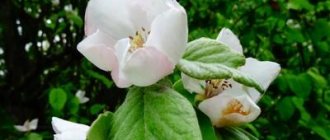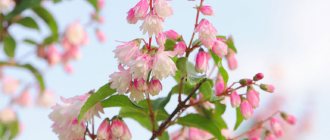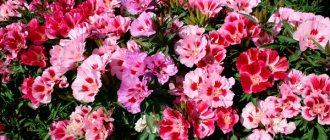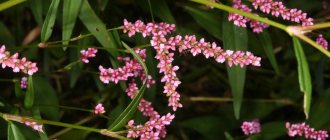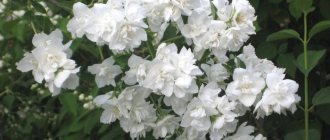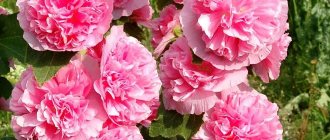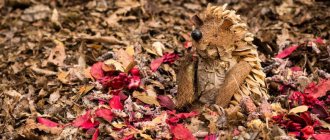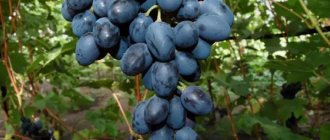Japanese quince or chaenomeles or Chaenomeles (as the name sounds in Latin) can often be found in front gardens, where dense hedges are formed with the help of this shrub.
It is an ornamental plant that produces bright red-orange, white, dark red, yellow-orange or light pink flowers in spring.
There are tall and low growing shrubs. In autumn, edible fruits ripen on quinces, shaped like apples, which are a real storehouse of useful substances.
History of shrub selection
Japanese quince or Japanese chaenomeles (Chaenoméles japónica) is a species of dicotyledonous plants that belongs to the genus Chaenomeles and the rose family.
This plant has been known for more than 4 thousand years. Japan is considered its , where it was grown primarily as a fruit shrub. Even ancient healers noticed the healing properties of this plant and actively used it to treat various diseases. In the wild, Chaenomeles can be found not only in Japan, but also in China and Korea.
Japanese quince was brought to European countries only in the 18th century, where it was immediately loved for its original appearance and bright flowers, therefore, here this shrub began to be grown as an ornamental plant and decorated with gardens.
Cooking recipes
After harvesting, the question of how to use the fruits of Chaenomeles japonica is inevitable. Fresh fruits are hard and tart. You can make jelly, pastille, compote. There are dozens of recipes for preparing Japanese quince for the winter.
Jam recipe. For 2 kg of quince take 1.25 kg of sugar and 240-250 ml of water. The pieces are blanched for 11-12 minutes, poured with syrup from water and 1 kg of sugar. After three hours, boil for 11-12 minutes, set aside for three hours. And so three times. Add the remaining sugar, bring to a boil, pour into jars, and close.
Compote recipe. Japanese quince – 1 kg, apples, sugar – 2 kg each. The fruits are poured with water and sugar and cooked for 12-15 minutes. Can be consumed immediately or rolled up.
Jelly recipe. For 1 kg of Japanese quince you need 850 g of sugar and 250 ml of water. The fruits are thinly sliced, water is added (so that it just covers the pieces). Boil until soft, strain the mixture, add sugar (750-800 g of sugar per liter). Simmer until thick.
Tea recipe. For a liter of water you need one fresh medium-sized fruit (or 2-3 dried), 5-6 tablespoons of green or black tea. Fresh Japanese quince is crushed, placed in a teapot, and tea leaves are added. Pour hot water for 10 minutes. You can use Japanese quince leaves in this recipe.
Where can you grow such a quince?
Chaenomeles japonica is widespread today :
throughout Europe;- in Central Asia;
- in the Caucasus;
- in Crimea.
The creeping form of the ornamental shrub is grown even in the northern regions of Russia, but so that it does not suffer from frost in the Moscow region, it is additionally covered in the fall.
In the southern regions, Japanese quince is formed as a multi-stemmed tree.
Growing goals
Japanese quince is an exotic plant that captivates with its beautiful flowers and aroma. It is very often used in landscape designs.
In this capacity, Chaenomeles can be used in different ways :
- as a central solo plant in the lawn;
- in group plantings in company with other bright-flowering shrubs;
- as a hedge;
- in composition with coniferous species;
- in combination with primroses and shrubs that bloom in spring (weigela, kerria, forsythia).
Chaenomeles can be used to form both a shrub and a tree - it tolerates pruning and modeling well. With this plant, your garden plot will turn into a fabulous corner.
also highly valued . They are very decorative and in the fall they are an additional decoration for the garden. In addition, the fruits are very useful and contain a whole storehouse of useful substances: vitamins, minerals, acids, biologically active components.
The pulp of the fruit contains stony cells, due to which it is very dense, therefore, it is practically not consumed fresh. Medicinal decoctions, compotes, jams, candied fruits are prepared from the fruits, and consumed baked.
How Japanese quince is used in landscape design
Chaenomeles japonica is valued for its decorative properties. It is planted to create hedges and placed along garden alleys, not far from gazebos. Shrubs are also used to form gardens in Japanese and English styles, combined with coniferous crops.
The most common tandem is flowering Quince and Barberries; shrubs with Peonies and different types of Juniper look good. If you grow a fruiting variety, you can either leave the fruit for the birds or try your hand at making Quince jam.
Description of the variety
Japanese quince is a deciduous shrub, the height of which does not exceed 1.5-3 m. There are also bushes with a height of 50 to 80 cm with a spreading, squat shape.
The shape and height of chaenomeles depends on the plant variety and the purpose of its use in landscape design.
Young shoots of Japanese quince are green, darken over time and become black-brown, scaly-felt, and then completely bare. The shoots are flexible and directed upwards.
Chaenomeles grows slowly; within a year the shoots increase in length by only 3-5 cm. The buds are black and bare. Many varieties of Chaenomeles have branches covered with closely spaced thorns up to 2 cm long. But there are varieties without thorns.
Leaves
The leaves are smooth, shiny, dense, spatulate or obovate in shape, slightly narrowed at the base. The edges of the leaves have small teeth. Leaf length is 3-5 cm, width - 2-3 cm. Young leaves have a beautiful bronze tint, and later become dark green. Petioles 5 mm long. Stipules are jagged, bean-shaped.
Flowers
Flowers can be of various shades: from white and pink to orange-red and crimson, up to 5 cm in size, collected in corymbose inflorescences of 2-6 pieces.
Flowers are placed randomly on the branches : sometimes in bunches, sometimes singly. The petals are almost round in shape. Japanese quince flowers are either ordinary or double, depending on the variety, they have many stamens and pistils of the same length, fused at the base.
Fruit
The fruits are yellow, greenish-yellow or bright orange, shaped like an oblong apple or pear. The top is covered with a waxy coating. The size of the fruit in diameter is 3-5 cm, the seeds inside are brown. The fruits of Japanese quince are edible, but tough.
More suitable for cooking:
- compotes;
- decoctions;
- desserts;
- jams;
- jams.
The fruits contain a large amount of organic acids, have a specific taste and pleasant aroma. Due to the presence of tannins, quince has a sour, astringent taste. Vitamin C and A content up to 1.5%. Fresh quince can be a substitute for lemon in tea, and added to dishes it will give them a slight sourness.
Full article about quince fruits here.
Root system
Chaenomeles has one powerful tap root , which goes 4-6 m into the soil. Thanks to this structure of the root system, Japanese quince can easily tolerate severe drought and takes root in any soil.
But precisely because of the deep root system, the plant is very difficult to tolerate transplants and then gets sick for a long time. Only young plants can be replanted painlessly.
What are the features of caring for Chaenomeles japonica?
The first year after planting is the most critical, since during this period the plant is vulnerable to disease and lack of care. To prevent the young shrub from dying, you need to pay a little attention to it.
Temperature
If you live in a cool climate, Japanese Quince is ideal for your garden as it is frost hardy and can survive temperatures as low as -30°C. But the plant finds it difficult to grow in regions with very hot climates. Many plants suffer from sunburn if they are exposed to temperatures above 30°C for several days.
Watering and mulching
Although it is a fairly drought-tolerant crop once established, young plants need to be watered from time to time.
It is worth watering in the morning so that excess moisture has time to dry before evening. Try not to get the leaves wet. Sprayed water can cause stains on the leaves, and they may also fall off if they are often wet. Mulch the base of Japanese Quince bushes to suppress weeds and maintain soil moisture.
Fertilizer
It is advisable to feed Chaenomeles japonica with a slow-release all-purpose fertilizer in early spring before new shoots appear, or add compost as a tree trunk fertilizer. Gently spread the fertilizer into the soil around the plant. Don't let the fertilizer touch the leaves - it can scorch the leaves. Then water the soil thoroughly so that the fertilizer is distributed to the roots.
Trimming
To maintain the attractive shape of the shrub, it requires regular and proper pruning. This plant can easily turn into a shapeless, overgrown bush if annual pruning is neglected. It is worth remembering that flowers form on old wood. Therefore, plan to prune in late spring, after flowering has ended.
There are three types of Chaenomeles haircuts:
- Sanitary . Carried out in the spring after flowering, all damaged, dry branches are removed. A saw and pruning shears are used for the work. The cut areas are treated with garden varnish.
- Forming . The formation of a bush begins only after 4-5 years of its growth. But every year it is necessary to remove part of the root growth, leaving a maximum of 2-3 offspring. The procedure is also performed in early spring. The most valuable are considered to be shoots that are horizontally located 30-40 cm from the ground. Shoots that grow upward need to be eliminated.
- Rejuvenating . Used for bushes that have reached 8 years of age. Branches older than 5 years of age are removed, leaving a maximum of 12-15 strong shoots. This will give your flowering Quince a neat look.
Is it possible to replant Chaenomeles japonica?
A shrub is not easy to replant if you plant it in the wrong place. The root system is very deep, and if you decide to dig up the bush when moving it, the parts of the root left in the ground will often grow back. It should also be taken into account that the branches of Japanese Quince are prickly. An adult plant does not tolerate the transplantation procedure well.
If the need for transplantation nevertheless arises, first you need to prepare a new place. It is best to replant shrubs during the dormant period from late winter to early spring, when the danger of frost has passed.
- Dig a hole two to three times wider than the root ball of the Quince bush.
- Dig up your plant from its old location. Outline an area approximately twice the size of its root ball and start digging from the boundary. As you go deeper into the soil, get closer to the root ball. When you start to see roots, work your way down. Pull the bush by the base to free it from the hole. If some of the roots are deep in the ground, cut them off with a flat spatula. Then pull Quince completely out of the hole.
- Move it to a new location. Place the shrub in the new hole at the same depth at which it was planted in the old place. You can tell this by the soil line on the trunk. Spread out the roots with your fingers.
- Fill the hole with soil. Once the hole is filled and compacted, water it to allow the soil to settle naturally. Add water until the soil is saturated with moisture.
- Mulch the soil around the transplanted bush to a thickness of 5-7 cm.
Characteristics
Chaenomeles loves sun, light partial shade is also suitable. In the shade the plant grows poorly and develops slowly. The place must be protected from winds, as wind negatively affects the flowering of the plant.
Japanese quince loves warmth, is relatively winter-hardy and does not tolerate severe frosts . As the bush matures, its winter hardiness increases.
In the southern regions, Japanese quince can withstand the winter without shelter, but if the shrub is grown in the middle zone, in Siberia or the Urals, then it must be covered with snow or additional shelter must be used. In frosty winters, the ends of young shoots may freeze.
Types: classification
Quince in bloom
The original classification included 3 types:
- Japanese
- Chinese
- evergreen
Over time, this classification was revised and only 1 species was identified: common quince.
Common quince
Quince pear-shaped
A single species includes 5 garden groups or varieties. All trees differ from each other in a number of biological features.
The first two are considered varieties of decorative quince: this is pyramidal - a tree with a pyramidal crown, and marble - with a variegated surface of leaves, densely covered with spots of yellow or white.
Garden quince is distinguished separately. It includes:
- pear quince
- apple-shaped
- Portuguese
Let's look at the representatives of the species in more detail.
Decorative quince
Ornamental quince All varieties included in this group have good resistance to drought, easily tolerate bad weather conditions, and can be grown in cities: they are not afraid of air pollution and dust.
In early spring, decorative quince looks very elegant: it is completely covered with spectacular flowers that stay on the plant for about a month.
In autumn, the bush is decorative due to its red foliage and bright yellow fruits.
All varieties must be trimmed to give the crown the desired shape.
Ornamental quince is a promising plant not only for decorating a summer cottage, but also for landscaping city parks.
Garden quince
Garden quince The group includes more than 400 varieties of fruit trees, but no more than 39 can grow in our climatic conditions.
Characteristics of garden quince:
- good winter hardiness
- high yield
- possibility of long-term storage of fruits
- good transportability
- disease resistance
Based on the shape of the fruit, quince is divided into pear-shaped and apple-shaped. According to the shape of the crown, the classification is as follows:
- spherical
- pyramidal
- broad pyramidal
The apple-shaped quince is considered the fastest ripening, while the pear-shaped quince has sweet and juicy fruits.
Main representatives with photos
Japanese quince is represented by several species that grow in Japan and China. Among gardeners it is better known as Japanese quince or Japanese chaenomeles. Also called chaenomeles beautiful and excellent. There are other garden forms, but they are all called by the same name - Japanese quince.
Popular chaenomeles of hybrid origin:
- Crimson and Gold is a plant with green glossy leaves and crimson flowers with golden stamens inside.
- Nicoline is a low plant up to 1 m in height and 1.2 m in width. Abundant flowering begins in mid-May. The flowers are large - up to 5 cm in diameter.
- Pink Lady is a flowering bush, up to 1 m high and wide with beautifully curved branches. Against the background of dark green glossy foliage, pink flowers with yellow stamens that bloom in May look beautiful.
- Orange Trail is a compact plant with a height of only 0.5 m. Suitable for decorating borders. Orange-red simple flowers with 5 petals bloom in May.
There are also varieties with different colors:
- Nivalis with white flowers;
- Sargentii – with orange-red;
- Malardy - pink with white border.
More information here.
Common pests and diseases of Chaenomeles
Aphids can seriously damage young branches and leaves, but this is not dangerous to the plant. Other insect pests that can be found on branches and leaves are scale insects and spider mites. They can be combated with insecticides or folk remedies.
Chlorosis (yellowing of foliage) can occur in high pH (alkaline) soils. In this case, you need to slightly acidify your soil.
If you notice dark green spots on the leaves that turn a dark rust color over time, your flowering quince may have apple scab, an infection caused by the fungus Venturia inaequalis. The fungus overwinters in vegetation debris and usually attacks in warm, humid weather. In this case, it is necessary to treat the plant with pesticides.
When does a tree bloom and fruits ripen?
The Japanese chaenomeles bush blooms in May-June, depending on the variety. Flowering lasts on average from 2 to 3 weeks. One flower lives about 6 days.
Flowering is very abundant ; more than 1,500 flowers can bloom on one bush. Active flowering is promoted by a large amount of sun, as well as competent, timely pruning. The fruits ripen at the end of September.
Harvest storage
The fruits of Japanese quince are covered with a light waxy coating, which protects them from damage and the first cold weather. However, despite this, it is better to remove the quince from the tree before the first frost.
When picking fruits, you should take into account that even very ripe fruits hold tightly to the branches, therefore, they should be picked carefully so that the plant is not damaged.
If the quince did not have time to ripen on the tree due to early frosts, then it can ripen in the refrigerator at a temperature of 3-5 degrees. Chaenomeles fruits can last in the refrigerator until spring.
The pulp of Japanese quince fruits is hard, astringent, and tastes like lemon. The seed box occupies almost half of the entire internal volume of the fruit. The seeds are smaller in size than apple seeds.
Fresh Chaenomeles fruits are not very tasty, but they can replace lemon when making tea, for example.
Most often, quince
is used as a raw material for cooking :
- jams;
- candied fruits;
- marmalade;
- jelly.
Sometimes fruits are simply cut into slices, sprinkled with sugar and thus stored in the refrigerator. Quince is also added to sweet preparations made from other fruits to add piquancy and flavor to desserts.
Application
Japanese quince was grown in our country decades ago. The bush attracts attention mainly in March-April, when flowers with unusually beautiful petals appear on thorny branches. There are many options for its use in many areas of life: gardening, landscape architecture, culinary arts, natural medicine, cosmetology.
Ornamental plant
Since quince blooms very abundantly and the flowers are brightly colored, the bush can be successfully grown to decorate gardens, roads and busy streets, where growing conditions are quite harsh. It beautifully decorates parks, classic and rocky gardens, terraces or balconies.
Quince bushes compact easily; when planted side by side, they form a compact structure. Proper formation will allow you to get a very interesting effect of a hedge, which is showered with flowers in early spring, and yellow fruits in the fall. Quince hedges decorate gardens and effectively protect against uninvited guests with thorns and dense branches. Even heavily pruned bushes bloom and bear fruit on old branches.
Tall, long, dramatic hedges can be created by combining quince with forsythia, ligustrum or barberry. Low-growing varieties are usually planted in uniform rows, for example, along alleys. On a meter-long plot you need to plant 3-5 bushes, depending on their growth vigor.
Ornamental Japanese chaenomeles is planted on slopes; it strengthens the soil well thanks to its very deep roots. Therefore, the bush is difficult to remove from the site.
You can even grow quince as bonsai - miniature trees that bloom in the second year of cultivation.
Growing rules
It is better to plant chaenomeles in sunny places protected from the wind. The soil for it should be :
- fertile;
- loamy or sod-podzolic;
- well drained;
- average humidity.
Water the bush no more than once a month. Loosening of the soil is carried out only when weeding weeds. They feed with nitrogen fertilizers in the spring, and apply potassium and phosphorus fertilizers after the plant has flowered.
Chaenomeles is pruned in early spring in order to remove frozen branches and prevent the plant from becoming too thick.
Due to the deep root system, it is not advisable to transplant Japanese quince from place to place. Only young plants survive transplantation painlessly.
During cold frosty winters, Chaenomeles needs to be covered with snow, and in its absence, shelters must be formed for it.
Read more about growing here.
Planting and caring for the exotic crop Japanese quince
One of the reasons for the popularity of this exotic is its ease of care. We will describe in more detail how to grow Chaenomeles japonica in the garden.
Where to plant shrubs
The plant tolerates full shade, but requires a sunny position for best fruiting. Make sure that there are no strong drafts at the planting site. Chaenomeles are often planted in a row to form a hedge. They need a lot of space for their crown. The optimal planting location will be the southern side of your site, protected from the winds.
Flowering Quince has large spines, so it is best placed away from high traffic areas where it can easily injure passersby.
Soil requirements
Japanese quince easily adapts to any sufficiently fertile soil and can grow well even on heavy clay soils. Like most plants, they prefer well-drained loam. Chaenomeles japonica can tolerate waterlogged soils, but not for long periods. Avoid soil with high pH (alkaline), which can cause chlorosis.
Sowing Japanese Quince seeds for seedlings
To plant shrubs, you can use purchased seedlings or grow them from seeds. If you are collecting seeds from an existing plant, they will need to be cold stratified before sowing. To do this, then place it in some peat moss or soil mixture in the refrigerator for three months.
Photo of Japanese Quince seeds
Seeds can be sown in late January or early February and should germinate within 30 days. For sowing, take trays with a soil mixture of 50% sifted compost and 50% river sand. Germinated seedlings should be moved to deep seedling pots. The largest plants can be planted in permanent places in the summer. The small plants should spend their first winter covered and can be planted out the following spring.
Planting Chaenomeles seedlings in the garden
If you plan to plant seedlings in spring, prepare the soil in the fall. Completely eliminate weeds in the selected area, add a little sand, potassium and phosphorus fertilizers (per 1 m² - 40 g) to the ground. The optimal period for planting is in the spring until the buds begin to bloom. It is not recommended to plant flowering Quince in the fall, as the seedlings do not take root well.
If you are planting a shrub as a future hedge, the distance between seedlings should be at least 50 cm. As an ordinary ornamental shrub, plant a seedling at a distance of 1.5-2 m from other plants.
Dig a hole twice as wide as the root ball and deeper than the seedling or seedling pot. Place the plant in the hole and cover with soil. When planting, make sure that the root collar is at ground level. Water the soil well. During the first year, while your young plant is taking root, you will need to water the bush when the top part of the soil is dry to a depth of 2 cm. It is advisable to mulch the planting site.
You might be interested
The best perennial bush flowers for the garden: features and selection rules
We use decorative coniferous shrubs in garden landscape design
The best shrubs for hedges
Reproduction
Chaenomeles japonica reproduces in several ways :
seeds;- cuttings;
- grafting:
- root shoots.
The easiest way is propagation by seeds. Very ripe fruits are cored and large brown seeds are removed.
They need to be sown in the ground in the same fall, since only fresh seeds have a high germination rate - up to 80% and produce vigorous shoots in the spring.
Propagation by cuttings or grafting is a more complex procedure, but the main advantage of these methods is that all varietal qualities of the plant are preserved.
Japanese quince produces a lot of root shoots, which is why the bush grows in width. Root shoots are dug up, choosing shoots up to 10-15 cm high and 0.5 cm thick with well-developed roots. From one bush you can get up to 5-6 new plants.
For more information about reproduction, see the article at the link.
Beneficial properties of Japanese quince seeds and leaves and contraindications for diseases
All parts of the plant have medicinal properties: fruits, branches, seeds and leaves.
Application of seeds
The seeds, or rather the white shell, contain mucous components that help relieve pain during menstruation if they are accompanied by heavy bleeding. The seed decoction is also used for eye diseases, sore throat, skin problems, be it burns or dermatitis, and also as a laxative. The seeds are brewed as tea and used for bronchitis, tracheitis and to normalize the gastrointestinal tract.
A few proven recipes:
- Pour 10 g of seeds into 100 ml of water and boil until the broth takes a jelly-like form. Drink a tablespoon three times a day;
- fresh seeds are taken as an astringent. They must be swallowed and washed down with plenty of water. Since the seeds are toxic, chewing them is strictly prohibited.
Quince seeds help with many diseases
Application of leaves
An infusion of leaves helps with gastrointestinal diseases, relieves inflammation of the stomach and an attack of bronchial asthma.
Preparation of the infusion:
- 5 g of leaves are poured into a glass of boiling water and boiled in a water bath for 5-10 minutes;
- Then the broth is infused for 2-3 hours, filtered and brought to the original volume with boiled water. Take 2 tablespoons three times a day before meals.
Leaves can be used either dry or fresh
Advantages and disadvantages
The main advantages of Japanese quince are:
- beautiful decorative appearance when the plant blooms in spring;
- edible and very healthy fruits, which contain more vitamin C than lemons;
- unpretentiousness of the plant to soil and external factors;
- easy care and reproduction;
- low susceptibility to diseases.
The disadvantages include:
- prefers areas that are illuminated and protected from the wind;
- does not tolerate severe frosts, requires additional shelter in winter;
- the bush is self-sterile; it is necessary to plant another plant nearby for cross-pollination;
- The plant must be pruned;
- eating fruits can cause an allergic reaction if you are hypersensitive to any component;
- people with gastrointestinal problems should not consume healthy fruits due to their high acid content;
- chaenemeles seeds are toxic.
Composition and nutritional value
Japanese quince is indispensable for humans, as it contains a large amount of vitamins, micro- and macroelements, which are so necessary for the body. The table shows the content of nutrients (calories, proteins, fats, carbohydrates, vitamins and minerals) per 100 g of fruit.
| Nutrient | Quantity | Daily value for an adult |
| Calorie content | 48 kcal | 1684 kcal |
| Squirrels | 0.6 g | 76 g |
| Fats | 0.5 g | 60 g |
| Carbohydrates | 9.6 g | 211 g |
| Organic acids | 0.9 g | |
| Alimentary fiber | 3.6 g | 20 g |
| Water | 84 g | 2400 g |
| Ash | 0.8 g | |
| Vitamins | ||
| A | 167 g | 900 mg |
| Beta Carotene | 0.4 mg | 5 mg |
| IN 1 | 0.02 mg | 1.5 mg |
| AT 2 | 0.04 mg | 1.8 mg |
| WITH | 23 mg | 90 mg |
| E | 0.4 mg | 15 mg |
| RR | 0.2 mg | 20 mg |
| Niacin | 0.1 mg | |
| Macronutrients | ||
| Potassium | 144 mg | 2500 mg |
| Calcium | 23 mg | 1000 mg |
| Magnesium | 14 mg | 400 mg |
| Sodium | 14 mg | 1300 mg |
| Phosphorus | 24 mg | 800 mg |
| Microelements | ||
| Iron | 3 mg | 18 mg |
| Digestible carbohydrates | ||
| Starch | 2 g | |
| Mono- and disaccharides | 7.6 g | Max. – 100 g |
| Saturated fatty acids | 0.1 g | Max. − 18.7 g |
Quince is equal in ascorbic acid content to lemon
